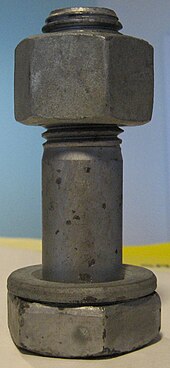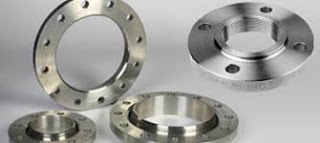304 Stainless Steel Fasteners
304 Stainless Steel Fasteners
 |
304 Stainless Steel Fasteners |
304 Stainless Steel Fasteners Suppliers
10 ) Excel Metal & Engg Industries
For Promotion Of Your Company Write Your Requirements In The Comment Box And Our Business Manager Will Assist You.
Thanks & Best Regards
Samarpan Thorat
9029137339
9029137339
(Marketing Manger - India)
A fastener (US English) or fastening (UK English)[1] is a hardware device that mechanically joins or affixes two or more objects together. In general, fasteners are used to create non-permanent joints; that is, joints that can be removed or dismantled without damaging the joining components.[2] Welding is an example of creating permanent joints. There are three major steel fasteners used in industries: stainless steel, carbon steel, and alloy steel. The major grade used in stainless steel fasteners: 200 series, 300 series, and 400 series.
Other alternative methods of joining materials include: crimping, welding, soldering, brazing, taping, gluing, cementing, or the use of other adhesives. The use of force may also be used, such as with magnets, vacuum (like suction cups), or even friction (like sticky pads). Some types of woodworking joints make use of separate internal reinforcements, such as dowels or biscuits, which in a sense can be considered fasteners within the scope of the joint system, although on their own they are not general purpose fasteners.
Furniture supplied in flat-pack form often uses cam dowels locked by cam locks, also known as conformat fasteners. Fasteners can also be used to close a container such as a bag, a box, or an envelope; or they may involve keeping together the sides of an opening of flexible material, attaching a lid to a container, etc. There are also special-purpose closing devices, e.g. a bread clip.
Items like a rope, string, wire (e.g. metal wire, possibly coated with plastic, or multiple parallel wires kept together by a plastic strip coating), cable, chain, or plastic wrap may be used to mechanically join objects; but are not generally categorized as fasteners because they have additional common uses. Likewise, hinges and springs may join objects together, but are ordinarily not considered fasteners because their primary purpose is to allow articulation rather than rigid affixment.
Industry
In 2005, it was estimated that the United States fastener industry runs 350 manufacturing plants and employs 40,000 workers. The industry is strongly tied to the production of automobiles, aircraft, appliances, agricultural machinery, commercial construction, and infrastructure. More than 200 billion fasteners are used per year in the U.S., 26 billion of these by the automotive industry. The largest distributor of fasteners in North America is the Fastenal Company.[3]
When selecting a fastener for industrial applications, it is important to consider a variety of factors. The threading, the applied load on the fastener, the stiffness of the fastener, and the number of fasteners needed should all be taken into account.[4] See below for material considerations.
Industrial fastener materials
There are three major steel fasteners used in industries: stainless steel, carbon steel, and alloy steel. The major grade used in stainless steel fasteners: 200 series, 300 series, and 400 series. Titanium, aluminum, and various alloys are also common materials of construction for metal fasteners. In many cases, special coatings or plating may be applied to metal fasteners to improve their performance characteristics by, for example, enhancing corrosion resistance. Common coatings/platings include zinc, chrome, and hot dip galvanizing.[5]
When choosing a fastener for a given application, it is important to know the specifics of that application to help select the proper material for the intended use. Factors that should be considered include
- Accessibility
- Environment, including temperature, water exposure, and potentially corrosive elements
- Installation process
- Materials to be joined
- Reusability
- Weight restrictions
Standards & traceability
ASME B18 standards on bolts, nuts, rivets, screws, washers, and similar fasteners[edit source]
The American Society of Mechanical Engineers (ASME) publishes several Standards on fasteners. Some are:
- B18.3 Socket Cap, Shoulder, Set Screws, and Hex Keys (Inch Series)
- B18.6.1 Wood Screws (Inch Series)
- B18.6.2 Slotted Head Cap Screws, Square Head Set Screws, And Slotted Headless Set Screws (Inch Series)
- B18.6.3 Machine Screws, Tapping Screws, and Metallic Drive Screws (Inch Series)
- B18.18 Quality Assurance For Fasteners
- B18.24 Part Identifying Number (PIN) Code System Standard for B18 Fastener Products
For military hardware
American screws, bolts, and nuts were historically not fully interchangeable with their British counterparts, and therefore would not fit British equipment properly. This, in part, helped lead to the development of numerous United States military standards and specifications for the manufacturing of essentially any piece of equipment that is used for military or defense purposes, including fasteners. World War II was a significant factor in this change.
A key component of most military standards is traceability. Put simply, hardware manufacturers must be able to trace their materials to their source, and provide traceability for their parts going into the supply chain, usually via bar codes or similar methods. This traceability is intended to help ensure that the right parts are used and that quality standards are met in each step of the manufacturing process; additionally, substandard parts can traced back to their source
 |
304 Stainless Steel Fasteners |
 |
304 Stainless Steel Fasteners |
 |
304 Stainless Steel Fasteners |
 |
304 Stainless Steel Fasteners |
Types
\
Types[edit source]
- anchor bolt
- batten
- bolt (fastener)
- brass fastener
- buckle
- button
- cable tie
- captive fastener
- clamp (or cramp)
- clasps
- cleco
- clips
- clutch
- drawing pin (thumbtack)
- flange
- frog
- grommet
- hook-and-eye closure
- hook and loop fastener
- latch
- nail
- pegs
- PEM nut
- pins
- retaining rings
- circlip
- e-ring
- rivet
- rock bolt
- rubber band (or bands of other materials)
- screw anchor
- snap fastener
- staple
- stitches
- strap
- threaded fastener
- tie
- toggle bolt
- treasury tag
- twist tie
- wedge anchor
- zipper
- anchor bolt
- batten
- bolt (fastener)
- brass fastener
- buckle
- button
- cable tie
- captive fastener
- clamp (or cramp)
- clasps
- cleco
- clips
- clutch
- drawing pin (thumbtack)
- flange
- frog
- grommet
- hook-and-eye closure
- hook and loop fastener
- latch
- nail
- pegs
- PEM nut
- pins
- retaining rings
- circlip
- e-ring
- rivet
- rock bolt
- rubber band (or bands of other materials)
- screw anchor
- snap fastener
- staple
- stitches
- strap
- threaded fastener
- tie
- toggle bolt
- treasury tag
- twist tie
- wedge anchor
- zipper




Comments
Post a Comment